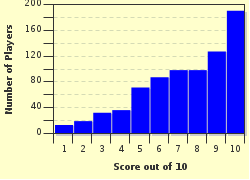Quiz Answer Key and Fun Facts
1. A spring is a fascinating object and such a seemingly simple creation has many physical concepts occurring when it is in motion. The general equation 'F = -kx' states that the force applied to the spring is proportional to the extension of the spring. What is the name of this physical law?
2. Isaac Newton was an inspiring physical scientist who revolutionised what we now know as classical mechanics in a way that no other scientist came close to replicating. One of his most famous equations is 'F = ma' which states that a force is the product of its mass and its acceleration.
True or False: If the mass (m) of an object is doubled and the acceleration (a) of the same object is halved, the force (F) would remain the same.
3. Pressure is a concept that is used extensively when considering the physics of gases and liquids. Which of the following is a simple explanation of what pressure is?
4. Electronics has a number of equations that range from the relatively straightforward to the mind-bogglingly difficult. One of the first equations that a physics student comes across when studying circuits is one that was proposed by Herr Georg Ohm in the 19th century and it has stood the test of time ever since. What physical concept did Ohm derive that is basically voltage per unit current?
5. Physics is known for its equations and calculations for the forces acting on an object that travels in a straight line. However, there is also a force that causes objects to move in a circular motion, such as the movement of a simple pendulum that rotates 360 degrees about an axis. What is this force that is also the subject of the equation F = (mv^2)/r?
6. Physics is often split into two classifications -classical physics and quantum physics. The world of quantum and nuclear physics is continuously evolving and has managed to capture the attention of the public, such as the experiments carried out by CERN. In the early days, the field had input from the likes of Planck and Einstein, the latter of which came up with the equation E = phi + Ek(max). What effect does this equation attempt to explain?
7. Granted, magnetism isn't the most exciting of topics but what is interesting is that you can feel the effects of magnetic force over a short distance. When you push two like poles of two separate magnets together you get a wonderful repulsion, a barrier of physical force that you are manipulating for your own nerdish pleasure. The force of magnetism (F) is defined by the equation F = BIl. What does the B represent in this equation?
8. Electrical charge, which can be stored by circuit capacitors, is measured in Coulombs (C) after the scientist of the same name. In SI units, one Coulomb is equal to [1A.1s]. Taking this into consideration, what is the equation for charge (Q) where current is (I) and time is (t)?
9. Ignoring the medium through which waves travel, the speed of a wave (v) is related to two things. Firstly, it is related to its wavelength which is measured in metres and secondly it is related to how many waves pass a certain yet arbitrary point per second. What physical phenomenon is the second factor describing?
10. Gravity is an intriguing phenomenon and it is one which we don't yet truly understand, however, the little we do know started with the work of Isaac Newton and has developed ever since. There is a specific type of energy which is related to the acceleration caused due to gravity and this is gravitational potential energy (GPE). What is the equation which represents GPE?
Source: Author
jonnowales
This quiz was reviewed by FunTrivia editor
crisw before going online.
Any errors found in FunTrivia content are routinely corrected through our feedback system.

